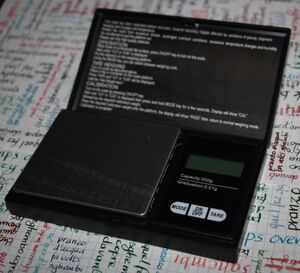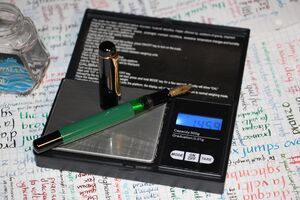Differenze tra le versioni di "Capacità dei sistemi di caricamento/en"
(Aggiornamento come da nuova versione della pagina di origine) |
|||
| Riga 40: | Riga 40: | ||
==Results== | ==Results== | ||
| + | |||
| + | In questa pagina si è riportata solo la tabella riassuntiva dei risultati delle misure, per un confronto diretto delle penne. I dettagli delle singole misure sono stati pubblicati (mancano i quelli relativi alle prime tre) in altrettanti articoli sul forum, che trovate indicizzati a [https://forum.fountainpen.it/viewtopic.php?f=8&t=21199 questo indirizzo]. | ||
<center> | <center> | ||
Versione delle 17:12, 9 mag 2020
One of the criteria with which the filling system is chosen, especially in recent pens, is that of its capacity. It is also one of the criteria on the basis of which we most frequently take sensational dazzles, also because there is a widespread prejudice that a piston filler pen contains much more ink than a cartridge filler one, which, with pens on the market today, is almost never true.
The following table of cartridge capacity is used as a reference (the measures mentioned have been collected on the internet, and have not yet been verified with the methodology adopted later; when they will be, the relevant column will be updated):
| Brand | Type | Capacity | Verified |
|---|---|---|---|
| Pelikan | short | 0,77 ml | no |
| Parker | long | 1.47 ml | no |
| Sheaffer | slim | 1.20 ml | no |
| Sheaffer | standard | 1.50 ml | no |
| Internazional | long | 1.66 ml | no |
For this reason it was decided to start a collection of measures of the actual ink capacity of pens, but for a measure to qualify as such (and not be reduced to a simple statement), it must be repeatable, so in addition to the results of the same, the methodology used to obtain it must also be detailed.
The measurements have been carried out using a scale with sufficient precision, capable to appreciate the hundredth of a gram (of those for weighing gold and jewellery, that you can find for about ten euros on the internet). To give an idea of the order of magnitude, a drop of water from a dropper is between 2 and 4 centigrams.
First the pen was weighed completely empty, washed and left to dry completely so as to avoid any residue due to liquid remaining in the feeder. Left to dry completely means holding the pen upside down with the nib resting on a sheet of absorbent paper for at least a week, so as to exclude any residual water.
Then the pen has been filled with tap water. For a comparison that takes into account the liquid remaining in the feeder, the weight was measured several times starting from the first filling of the empty and dry pen, repeating the loading and unloading cycles.
The filling was carried out normally as you do when you load the ink for writing, removing the excess liquid from the feeder (shaking it slightly to drip and placing the nib near the neck of the bottle to remove excess) and drying the one that may be present on the section. An ordinary bottle of ink was used (Waterman 50 ml, but any one is fine, just soak the pen tip completely in it).
We measured several times (at least 10) the weight both when the pen is loaded and when the pen is unloaded. From the various measurements the weight for a loaded and unloaded pen was obtained by calculating average and standard deviation. There is no point in using the highest value, the perfect filling does not exist, what is an indication of how much in ordinary use the pen actually charges, is the average.
The value when the pen is discharged used to estimate how much liquid remains in the feeder, but we took as an indication of the filling capacity the value when the pen is fully filled, because pens are filled once the ink is finished and no longer reaches the nib, and this also includes the one present in the feeder. However, you can use the weight of the unfilled pen for a fairer comparison with the capacity of the cartridges, as it indicates the capacity of the filling system alone (with cartridges the additional capacity of the ink held by the feeder when it is immersed in the ink bottle to charge the pen is not available).
The capacity in ml was then determined using the specific weight of the water which is 0,997 g/ml. The difference between tap water and pure water is below the appreciable limits of the measurement in centigrams, and inessential for the measurement whose accuracy is ±0.02 ml (sum of the systematic error of 0.01 g of the scale in the difference between two measurements, even if the error is always higher for a filled pen weight measurement), for the conversion, however, we can substantially assume an equivalence of 1 g => 1 ml being the difference below the measurement error.
Results
In questa pagina si è riportata solo la tabella riassuntiva dei risultati delle misure, per un confronto diretto delle penne. I dettagli delle singole misure sono stati pubblicati (mancano i quelli relativi alle prime tre) in altrettanti articoli sul forum, che trovate indicizzati a questo indirizzo.
| Pen | Type | Empty | Filled | Unloaded | Capacity |
|---|---|---|---|---|---|
| Pelikan 140 | piston | 14,33 ± 0,01 g | 15,98 ± 0,04 g | 14,59 ± 0,03 g | 1.65 ± 0,05 ml |
| Duofold De Luxe | button | 22,10 ± 0,01 g | 24,00 ± 0,03 g | 22.35 ± 0,03 g | 1.90 ± 0,04 ml |
| Lamy 2000 ('60s) | piston | 20,88 ± 0,01 g | 22,68 ± 0,02 g | 21,59 ± 0,02 g | 1.80 ± 0,03 ml |
| Pelikan 481 | piston | 12,97 ± 0,01 g | 14,60 ± 0,01 g | 13,29 ± 0,01 g | 1,63 ± 0,01 ml |

